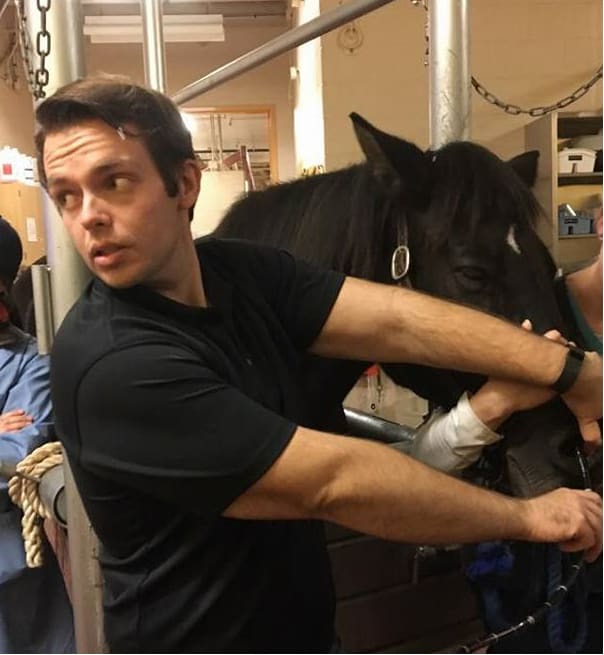Stop the Spread of Equine Infectious Disease

How equine veterinary clinics institute strict biosecurity measures to contain disease
Ah, 2020: The year the general public became acquainted with the terms quarantine and isolation, and PPE went from meaning “prepurchase exam” to representing “personal protective equipment.” Equine veterinarians like myself, however, were dealing with infectious disease outbreaks long before COVID-19 hit the scene. Since the advent of equine hospitals, their personnel have been tasked with biosecurity. In this article we’ll highlight exactly how clinics both prevent disease and control outbreaks.
Why the Worry?
Horse hospitals aren’t all full of sick horses. Rather, they see a plethora of cases, the types of which typically depend on the center itself. Surgical facilities, of course, see primarily surgery cases: orthopedic, soft tissue, and colic. Reproduction clinics are filled with broodmares and foals. Hospitals with internal medicine specialists might see horses with everything from pneumonia and eye problems to endocrine disease and neurologic conditions.
The problem is horses. Seemingly healthy horses can harbor diseases that only manifest during times of stress. These stresses can include things like trailering, new environments, and pain. See where I’m going with this?
Bacteria such as Salmonella and methicillin-resistant Staphylococcus aureus (MRSA) can lie dormant in the horse until a stressor causes him to start shedding the pathogen. Many hospitals and referral centers swab horses for Salmonella on admittance to know exactly how many carriers are entering and exiting the clinic. This practice can thwart outbreaks; for example, a hospital admitted a horse for castration, only to find the colt was a Salmonella carrier on arrival. The surgeon completed the procedure, but the horse remained in isolation during his visit, as he could’ve easily spread Salmonella to others in the main hospital barn.
Protocol and Principles
So how do clinic staff contain disease and keep their patients healthy? Tracy Norman, VMD, Dipl. ACVIM, has worked in both academia and private practice and highlights some of the hospital biosecurity principles she has spearheaded over the years.
Ease of Use
“Any written protocol devised by an infectious disease committee full of brilliant clinicians and scientists is only as good as the student or animal caretaker who is least interested in compliance,” she says. Protocols cannot be brimming with long, hard-to-understand words or be inconvenient, complicated, or poorly communicated. Staff simply won’t be able to follow them.
She suggests posting plenty of signs featuring photos or illustrations—and instructions in the languages spoken by personnel—and simple workflow protocols; establishing convenient and well-stocked hand-washing stations; and providing ample PPE in convenient locations, along with plenty of trash receptacles.
Teamwork
For protocols to be effective, everyone must adhere to them. “Whatever the higher-ups do (not say) is modeled by everyone else,” she says. “If the senior clinician skimps on PPE, so will the students, the techs, everyone.”
Workflow
“There must be an area designated for isolated patients, a workflow or workforce to keep cross-contact to a minimum, and a traffic pattern that keeps the isolated area and the general population area distinct and separate,” Norman says.
Facility Design
Equine hospitals and referral centers are like snowflakes; no two are the same. “One of the key elements is to design the hospital with people traffic in mind, since people (via hands and shoes) could be a main source of spreading contagious infectious diseases around the hospital,” says Lucas Pantaleon, DVM, MBA, Dipl. ACVIM, owner of DVM One Health, in Versailles, Kentucky, a consulting firm specializing in infection prevention and biosecurity.

Diminishing traffic diminishes spread. Period. “It is key to have easy access to sinks with soap in order for people to wash their hands,” he says, echoing Norman’s recommendations. “If people need to walk from one end of the hospital to the other to wash hands, then it is less likely that they will do it, or on the way to wash their hands they could touch and contaminate surfaces.”
Having PPE—those gloves, shoe covers, and disposable gowns—available in multiple parts of the clinic is also a necessity.
Human traffic isn’t the only factor here. Minimizing horse traffic also reduces spread from the source itself. “The back (exterior stall) door should be used for horses and mucking stalls,” Pantaleon says. “The front door should be used for veterinarians and technicians attending the horses. This way, human traffic is mainly concentrated inside the barn and horses come in and out from the outside.”
Traffic principles can also apply to non-patients. While clinic cats are wonderful and a staple of most stables, they don’t need to nap in equine isolation before strolling through the surgical wing.
The Importance of Isolation
While good protocols are the backbone of biosecurity, they only work if you have a structure dedicated to containing sick horses. These barns vary from clinic to clinic—the key factor being they’re physically separate from the main barn.
“At a tertiary referral institution, you are talking about high-end isolation buildings that have individually airtight stalls with negative pressure ventilation systems,” says Pantaleon. These ventilation systems remove air from buildings through ducts in the stalls, rather than diffusing it into the surrounding (interior) environment. This prevents air with potential contaminants from moving between stalls. You typically find these buildings in veterinary teaching hospitals or large referral centers. While they are the gold standard, they are the least common isolation units in North America due to their cost and complexity.
Instead, most equine hospitals’ isolation buildings are relatively primitive, but their design allows them to be effective. “A key feature would be to be separated from the main hospital about 100 feet,” says Pantaleon. “Stalls should be built of a nonporous material that would be easy to clean and disinfect.” Distance and disinfection are the principles of equine isolation.
Again, managing people flow is key: “Ideally, personnel dealing with isolated cases need to minimize contact with the rest of the hospital population,” he says. “So having a nurse station in isolation that would be stocked and equipped (with its own PPE that does not leave the build- ing), preventing sharing of equipment.”
In my experience, many isolation buildings are run by a primary technician responsible for the care of the animals in isolation, who doesn’t interact with cases in the main barn. People entering and exiting the isolation stalls are often required to disinfect their footwear in foot baths.
Inevitably, some hospitals do not have isolation barns for receiving infectious, or likely infectious, horses. “At a hospital that is not equipped to have infectious diseases in there, that horse would ideally be sent to a referral center with a good isolation protocol in place where you can safely treat those cases,” says Pantaleon. “You have to think what you are capable of, what you have, and not try to over- reach, because that could backfire.”
Farm Biosecurity Tips
Your average backyard barn or boarding stable obviously won’t offer the same luxuries as a referral center, but that doesn’t mean you can’t establish your own biosecurity protocols. Quarantining newly arriving horses for a week or two, ideally in a separate barn or an isolated paddock without a shared fence line, is a great place to start. Plus, requiring vaccinations for infectious diseases such as influenza, equine herpesvirus, and strangles, along with a negative Coggins test (which rules out equine infectious anemia)—as many boarding facilities do—can help. The latter is usually also a necessity for competitions at local, national, and international levels.
If an outbreak does occur on your farm, what can you as an owner do to help the sick animals while protecting the healthy ones? “If possible, we try to convert one portion of the farm to a makeshift isolation ward,” says Mark Wallace, DVM, Dipl. ACVIM, a partner at Carolina Equine, in Browns Summit, North Carolina. The sick horses are the only ones housed here, and no others are brought in. “We create as much physical distance between this area and the rest of the herd. Ideally, this is a separate barn, but if this is not possible we just create as much distance as possible.”
Also assign an isolation barn caretaker. With only one person entering the structure, it reduces the risk of bringing the infectious agent to the rest of the herd. Using footbaths and PPE such as gloves and disposable gowns also helps prevent transmission between horses. Finally, do not share any equipment used on or around the sick horses. Manure forks, water troughs, brushes, and wheelbarrows can be contaminated by infectious agents and must not be used when managing the rest of the herd
—Chris White, DVM
Outbreak Control
Preventing disease spread is much easier than battling a (potentially unknown) infectious agent that has been allowed to proliferate through the barn. Mark Wallace, DVM, Dipl. ACVIM, a partner at Carolina Equine, in Browns Summit, North Carolina, describes signs that make veterinarians leery of an infectious source: “Fever, diarrhea, cough, nasal discharge, acute onset progressive ataxia (incoordination), and enlarged lymph nodes are all suspicious of an infectious agent.”
As an ambulatory veterinarian, when I get calls like these, I will either see them at the end of my day if the horse is stable or see a dire case directly and reschedule routine appointments so I won’t have to see another horse that day. Vets and other equine professionals such as farriers and trainers can easily spread disease unknowingly. Anytime you have a case like this, presumptive precautions are best.
Say a horse from colic surgery is starting to show signs of a fever and profuse diarrhea three days post-surgery. He’s likely in the main barn, surrounded by other patients. What does the clinic staff do? “Isolate any animals that display any signs of infectious/contagious illness,” says Norman. “Do this immediately. Do not wait to see exactly what is going on.”
Identifying the infectious agent is the next step, but collecting and testing samples takes time. In the meantime, you must consider the other horses in the barn. “Contact tracing is implemented to identify places the patient has been in the 48 hours prior to onset of concerning signs and any other animals that have been in direct contact,” says Norman.
Horses that were in contact are usually on an imposed quarantine, as in they stay exactly where they are put. Any horse that develops clinical signs shortly after con- tact also moves to isolation immediately.
“Any spaces/equipment that have been exposed to the infected animal are closed off to traffic, cleaned and disinfected, and environmental surveillance (e.g., testing surfaces) is instituted,” Norman says. “The area is not reopened until demonstrated through environmental surveillance to be uncontaminated,” which could be weeks.
Take-Home Message
Biosecurity has been and always will be a priority for equine hospital personnel. Years of research go into every clinic’s protocols and principles. Know that if your horse is referred to an equine hospital— regardless of the reason—the facility has procedures in place to safeguard him and avoid spread of infection.

Written by:
Chris White, DVM
Related Articles
Stay on top of the most recent Horse Health news with












